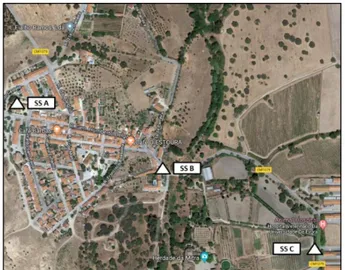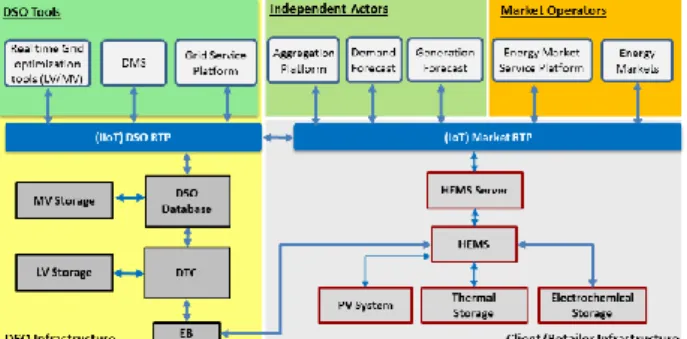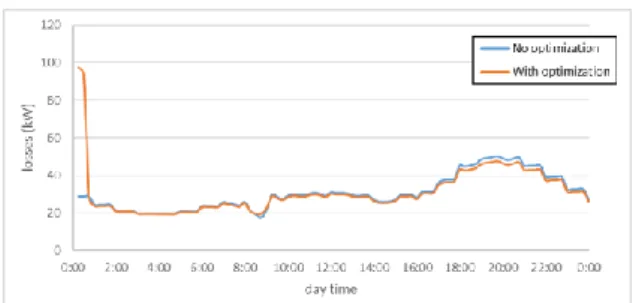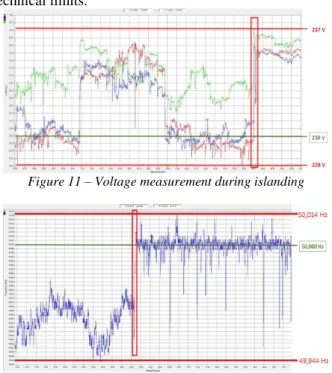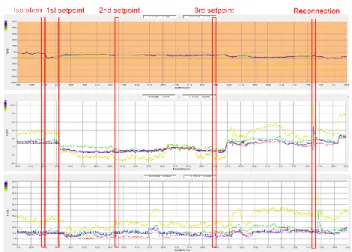HAL Id: hal-02902684
https://hal.archives-ouvertes.fr/hal-02902684
Submitted on 20 Jul 2020
HAL is a multi-disciplinary open access
archive for the deposit and dissemination of
sci-entific research documents, whether they are
pub-lished or not. The documents may come from
teaching and research institutions in France or
abroad, or from public or private research centers.
L’archive ouverte pluridisciplinaire HAL, est
destinée au dépôt et à la diffusion de documents
scientifiques de niveau recherche, publiés ou non,
émanant des établissements d’enseignement et de
recherche français ou étrangers, des laboratoires
publics ou privés.
Filipe Guerra, Ricardo André, Ricardo Santos, Alexis Bocquet, Andrés
Alcantara, Catherine Murphy-O'connor, Clara Gouveia, José Damásio,
Salvador Rodriguez
To cite this version:
Filipe Guerra, Ricardo André, Ricardo Santos, Alexis Bocquet, Andrés Alcantara, et al.. Storage and
Energy Management enabling Grid and Market Services: SENSIBLE’s Portuguese real demonstration
results. CIRED 2019 - 25th International Conference on Electricity Distribution, Jun 2019, Madrid,
Spain. �10.34890/904�. �hal-02902684�
Storage and Energy Management enabling Grid and Market Services:
SENSIBLE’s Portuguese real demonstration results
Filipe GUERRA Ricardo ANDRÉ Ricardo SANTOS
EDP NEW R&D EDP NEW R&D EDP Distribuição
filipe.guerra@edp.pt ricardo.andre@edp.pt ricardojorge.santos@edp.pt
Alexis BOCQUET Andrés ALCANTARA Catherine MURPHY-O’CONNOR
MINES-ParisTech, PERSEE University of Seville INDRA
PSL – Research University aalcantara@gte.esi.us.es cmurphy@minsait.com alexis.bocquet@mines-paristech.fr
Clara GOUVEIA José DAMÁSIO Salvador RODRIGUEZ
INESC TEC Siemens SA GPTech
clara.s.gouveia@inesctec.pt jose.damasio@siemens.com srodriguez@greenpower.es
ABSTRACT
An intelligent integration and a coordinated use of distributed generation and small-scale energy storage devices (DSO and client owned) combined with the flexibility provided by end-customers can significantly contribute to improve the robustness, resilience and flexibility of the distribution grid (MV/LV), a common goal for Distribution System Operators.
SENSIBLE1 project aims for energy storage sustainability
and three demonstrators were deployed (Portugal, England, Germany) in order to prove the capabilities of distributed small-scale Energy Storage Systems (ESS). In Portugal, 5 Use Cases (UC) were tested to demonstrate storage for grid operation and end-customer applications. From high-level tools to low-level control systems (grid and residential automation), a complex ICT architecture was developed in order to enable the conditions to test all the Évora’s functionalities.
This paper presents the final results of the real environment challenging tests focusing on the technical, economical and societal conclusions Évora (Portugal) demonstrator.
INTRODUCTION
The focus of Évora demonstrator was to prove that distributed small scale storage technologies can be used as a DSO asset for the optimization of the LV/MV distribution network operation as well as a client asset for the provision of flexibility energy services in a market perspective. In that sense Valverde’s networks and some clients were provided with the necessary equipment to enable the demonstration of these functionalities.
Demonstrator Topology
Évora demonstrator test bed is located at Valverde, a rural village (Évora’s county), counting with around 450
1 H2020 – LCE 08-14-. Grant agreement No 645963.
inhabitants (around 240 low voltage clients, all equipped with the last generation GPRS Smart Meters from EDP Distribuição Inovgrid architecture). The demonstrator network is composed by one radial MV feeder (without redundancy) from HV/MV Évora Primary Substation which feeds two public Secondary Substations (SS A and SS B). There is still a third client owned SS (C) which feeds a MV client, the Évora Veterinary University. An aerial overview of the demonstration village can be depicted below.
Figure 1- Valverde demonstrator aerial view
On the grid side, electrochemical Energy Storage Systems (Lithium-Ion) were installed as well as a new cabinet Secondary Substation (SS A) equipped with the required automation for SENSIBLE’s challenges [1]. The storage installed in the grid is used for LV grid normal (grid connected) and emergency (islanded) operation. The systems were sized (power and capacity) such that they should be capable to ensure islanding operation for at least 90% of yearly time during at least 30 minutes. The final
sizing resulted in the following systems:
ESS1 (V/f or P/Q): Located at secondary substation level with capacity of 50kW/102 kWh (SS A)
ESS2 (P/Q): Located at feeder level with capacity of 30kW/27 kWh (SS A)
ESS3 (P/Q): Located at feeder level with capacity of 30kW/27 kWh (SS B)
ESS4 (P/Q): Located at feeder level with capacity of 10kW/22 kWh (SS A)
SENSIBLE also made use of an already existing MV Storage System (Lithium-Ion, 480/360 kW/kWh) connected to the MV client Secondary Substation [2]. On residential grid side, two storage technologies were elected. In total, 25 clients were chosen (from an application process) and enabled with microgeneration and storage equipment:
10 clients with PV and battery (1.5kWp and 2.4/3.0 kW/kWh)
10 clients with PV and Water Heaters (1.5kWp and heaters from 30 to 200L)
5 clients with PV, Battery and Water Heaters (1.5kWp, 2.4/3.0 kW/kWh and heaters from 30 to 200L) All the 25 participants were enabled with a Home Energy Management System (HEMS) integrated with the clients’ smart meter, to monitor and control the residential assets.
ICT architecture
From high-level tools (ranging from MV/LV Grid Optimization, Production/Consumption Forecast, Flexibility Aggregation and Markets Emulation) to low-level control systems (Distribution Transformer Controller [grid automation] and Home Energy Management Systems [residential automation]), a complex ICT architecture (Figure 2) was developed and deployed in order to enable the conditions to test all the Évora’s functionalities. Two parallel infrastructures (installed in two different networks) were created in order to divide the regulated environment (DSO) end the market environment (Client/Retailer). The main goal was to ensure data privacy and protection, complying with the recently launched GDPR.
Figure 2 - Évora demonstrator ICT architecture.
TESTS AND RESULTS
UC2 – Flexibility and DSM in the market participation UC2 was designed having in mind the test of a business model where an aggregator providing a service to a retailer (or a retailer itself) would try to, on the day-ahead wholesale market, allocate as much consumption during the cheapest hours, as the available flexibility would enable it, so that it could decrease the consumption during the most expensive hours.
Figure 3 - Example of day-ahead flexibility allocation Then, during the following day, in an intraday basis, the aim of the aggregator (or retailer) is to diminish as much as possible the deviations between the energy bought on the day-ahead, including the allocated flexibility, and the actual consumption.
Figure 4 - Example of intraday flexibility allocation The available flexibility of each client (and then the portfolio) both on day-ahead and intraday scenarios is calculated by the Aggregation Platform which uses consumption and generation forecasts for both scenarios. All the requests from the retailer are technically validated by the DSO which can as well request flexibility to solve technical constraints (voltage problems) on the grid. On Figure 5 and Figure 6 present the response of two of the residential controllable systems to the DSM requests from the flexibility auction on a representative day.
Figure 5 - Example of PV Production and flexibility (curtailment) intraday requests
Figure 6 - Example of WH consumption and intraday flexibility requests
All things considered, the PV was the appliance which presented the best responses to requests. On the other hand, the water heater presented the lowest accuracy performing, mainly due to the imposed temperature limits by each client as well as the local used communication technology (PLC which presented some failures). The battery provides the higher flexibility (to increase or decrease the client consumption) but is also the most complex equipment to control due to technology constraints.
Due to the selfconsumption maximization strategy implemented in the 25 HEMS, it’s estimated that, in average, each participant, from the Portuguese demo site, saved 25€ each month on their energy bills (somewhere half of the national monthly bill in that segment). On the other hand, the extra benefit from the participation in the flexibility auction services depend on the business model agreed with the retailer or with an aggregator.
During the more than 1 year of operation of the residential demonstrator, from all the energy generated by the PV systems of the 25 participants, 39% was internally consumed by them, 10% was stored in the batteries, 16% was stored in the Water Heaters and around 35% was injected in the network. This 35% show that there is still a margin of improvement on self-consumption strategies as well as on the exploitation of flexibility in the market.
UC8 - Optimizing the MV Distribution
A single ESS was available to participate in MV network operation. In order to demonstrate the operation of the MV Storage Optimization Tool, a representative day was chosen. The MV Opt. tool makes use of aggregated load (using historical data of all SS in the MV feeder) and generation forecast (from a PV plant connected to that feeder) diagrams for the MV network.
A reference voltage of 1.0 p.u. was considered in the MV network reference bus (HV/MV connection) as well maximum and minimum voltage limits of 1.1 p.u. and 0.9 p.u., respectively, for all nodes of the MV network. As a pre-condition of this UC, the MV ESS must ensure enough 1 hour of reserve capacity to support the load forecasted for Évora University in case of failure on energy supply. In this representative test, with no voltage limit violations foreseen considering the load and generation
forecast, the MV Opt tool aims to reduce energy losses. Aiming for higher efficiency, in this case, the tool only dispatches reactive power, shown in Figure 7. The impact on the energy losses of the network are depicted in Figure 8.
Figure 7 - Reactive power set-points generated by the MV Storage Optimization Tool
Figure 8 - Active power losses in the MV network on 16th August 2018
This UC showed that preventive management approach proposed based on the load forecasts allows to exploit the storage inverter capacity to improve network operating conditions, in terms of voltage profile and energy losses, achieving during the demonstration period 5% improvement on the voltage profile as well as a reduction of around 11% of energy losses.
UC9 - Optimizing the operation of storage devices
in the LV network
This section presents the results obtained by the LV Optimization Tool running in real-time, aiming to decrease energy losses and improve voltage profiles based in day-ahead and intraday forecasts for load and generation. For LV network of SS A, in addition to the optimization of LV network, the tool also tries to ensure adequate reserve capacity for grid forming storage units (ESS1, ESS2, ESS4) to support the operation of this network in islanded mode. Several scenarios of dispatch strategies (active and reactive power) were tested as well as for different constraints (regulatory values of ±10% for voltage profiles, and stricter ranges).
It is presented a representative test on network of SS B on a day where the predicted voltage profiles would surpass the regulatory range of operation. Aiming for a more effective impact on the voltage profile, in this case, the tool
only dispatched active power, shown in Figure 9. The predicted voltage profile and the impact of the ESS control are depicted in Figure 10.
Figure 9 - Active power set-points generated by the LV Storage Optimization Tool
Figure 10 - Maximum voltage levels registered for the LV Network on one day
This UC showed that preventive management approach proposed based on the load, generation and flexibility forecasts allows to exploit the storage capacity to improve network operating conditions, even in more challenging networks as the LV (highly imbalanced, great amount of data to be managed). In this UC, voltage control presented inferior results than UC8, only with a 0.5% improvement on the voltage profile but it achieved as well as a reduction of around 11% of energy losses.
UC10 - Islanding Operation of LV networks
The main objectives established for this use case were to ensure a secure and smooth transition to islanding operation and the system stability while providing an adequate voltage and frequency regulation under the acceptable range defined by the grid code.After ensuring all the necessary conditions (communications, equipment availability, grid load, etc…), the DSO proceeds to the isolation of the LV network. Figure 11 and Figure 12 present voltage and frequency at the terminals of ESS1 which is directly connected to the secondary substation. It is possible to verify that the frequency and voltage in islanded operation remain within the regulated technical limits, which for voltage are 230V ±10% (207 – 253 V) and for frequency are 50 Hz ±1% (49.5 – 50.5 Hz). The red rectangles present the moment when the isolation circuit breaker closes, after all the reconnection conditions (synchronism) are verified. It can be perceived that even in the transitory periods, the
voltage and frequency excursions remain within the technical limits.
Figure 11 – Voltage measurement during islanding
Figure 12 - Frequency measurement during island To ensure three phase voltage regulation with high imbalance between phases and automated disconnection and reconnection is a great technical challenge that was overcome on Évora demonstrator. UC10 proved that the DSO can operate a LV network, only resorting to storage systems and local automation, ensuring the regulated quality and continuity of supply.
UC11 - Microgrid Emergency Balance (LV and
MV)
UC11 included the operation of islanded networks in two voltage levels, presenting different complexities.
LV islanded operation
The LV MG Emergency Balance Tool runs online calculating the emergency plan for the network of SS A, based on the load, microgeneration and grid awarded flexibility forecasts. The opening of the islanding circuit breaker (UC10) triggers the MG Balance tool which calculates the optimal setpoints for each distributed unit (ESS2 and ESS4). Figure 13 provides the power output of each one of the units (upper ESS1, middle ESS2, lower ESS4). After the isolation, ESS1 (V/f source) sustains all the load until that ESS2 and ESS4 receive the calculated setpoints. The islanding operation runs around 40 minutes, and every 15 minutes the distributed ESS receive a new setpoint based on the consumption/generation forecast. After the reconnection (UC10) the MG Balance tool is disabled and the systems start operating again aiming to optimize the LV network (UC9).
UC11 (LV) proved that with the implementation of the correct strategy on automation control tools (resorting on
reliable forecasts and field measurements), the operation on islanded mode can be maximized. From 2015 to 2018, with the existing solution in Valverde, it would have been possible to supply around 87% of the energy not supplied during that time.
Figure 13 - LV network isolation test
MV islanded operation
The main objective of the MV Network Islanded Monitoring and Balancing Tool is to manage the storage capacity of the MV network in order to ensure a secure islanding and maximize the time the network can operate in islanded mode. The tool evaluates the technical feasibility of islanding the end of the MV feeder composed by SS A and SS B networks, and also by MV consumer (SS C). During islanded operation, the MV ESS is operated as grid forming, while the remaining ESS operate as grid supporting units (ESS1, ESS2, ESS3 and ESS4). At a periodicity of 15 minutes, the tool updates the emergency plan, trying to generate an operational plan that guarantees the security of MV islanded operation. Figure 14 depicts the power measurements in the coupling point of MV ESS (upper), SSA (middle), SS B (lower). As in the previous case, the opening of the islanding circuit breaker (MV) triggers the MV MG Balance tool. After the isolation, MV ESS (V/f source) sustains all the load until the LV units receive the calculated setpoints. The islanding operation runs around 40 minutes, and every 15 minutes the distributed ESS receive a new setpoint. On the moment that the 1st setpoint reaches the field, it is possible to see
that SS A starts injecting power on the MV network aiming to supply the power demand of SS B and saving energy on the MV ESS. After the reconnection, the MV MG Balance tool is disabled and the systems start operating again aiming to Optimize the LV and MV network (UC8 and 9). UC11 (MV) proved that the coordination of equipment at different voltage level with the implementation of the correct strategy on automation control tools (resorting on reliable forecasts and field measurements), can maximize islanded operation time. Similarly, this UC proved that from 2015 to 2018, with the existing storage solution in Valverde and islanding capabilities, it would have been possible to supply around 99% of the energy not supplied during that time to the three Secondary Substations.
Figure 14 - MV network isolation test
CONCLUSIONS
Évora demo could demonstrate innovative developments and new services based on energy storage and management technologies applied to grid and end-user. The success of Évora demonstrator involved the engagement of legal and regulatory authorities in order to proper framework the project in terms of regulation and licensing for operation, as well as the engagement of the local authorities and population to actively participate on the several steps of the project. After the definition of functionalities and architectures/systems as well as its development, the laboratory validation in EDP Labelec and INESC TEC labs was a fundamental quality insurance step before the real onsite demonstration. On market side, it was proved possible to contribute with customer’s flexibility to improve market participation results as well as to support the DSO on distribution grid operation in case of any technical constraints, while saving in average around 300€ in the energy bill (client per year) with parallel strategy for the maximization of self-consumption. On the grid side, it was proven that storage can influence both quality of services (average decrease of 11% on energy losses and improvement up to 5% of voltage profiles) as well as outage time minimization (LV and MV islanding secure operation for more than 40 minutes, and more time was possible). In steady state regimen, storage is able to be operated considering the optimization of grid voltage profiles and congestions minimizations, both at low and medium voltage. Also in emergency regimen, it was proved that storage is able to ensure the energy supply to customers when an outage occurs in the main grid.
